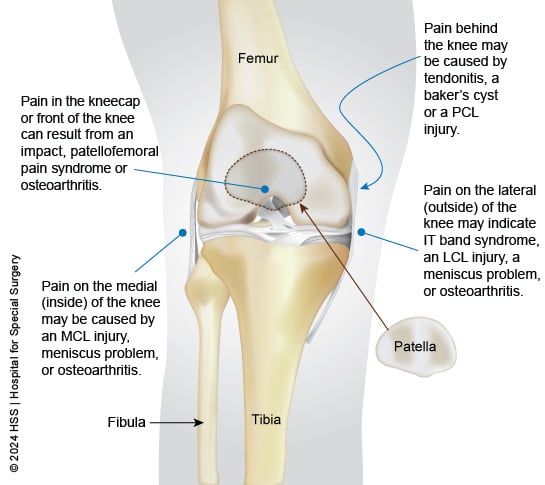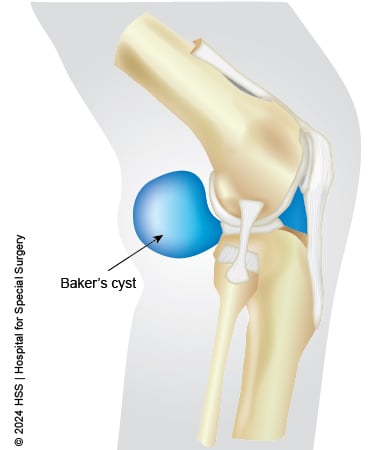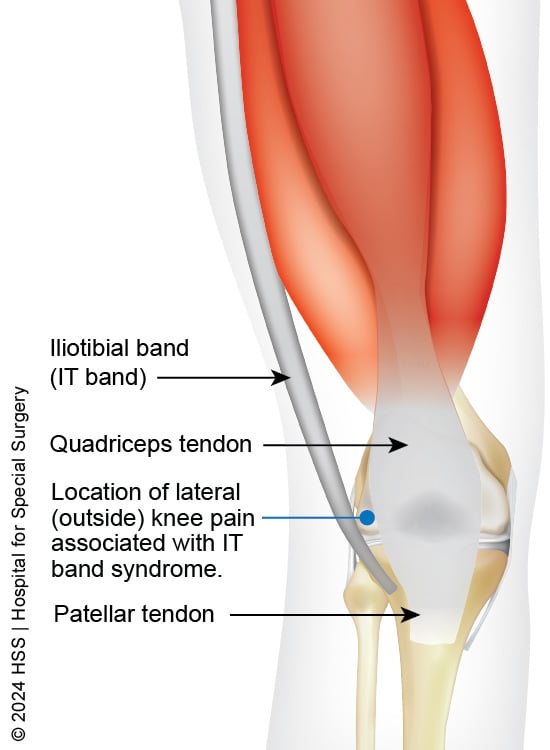Knee Pain Causes, Conditions and Treatments
Knee pain is a very common problem. If your knee has been bothering you for a while or keeping you from activities you enjoy, read on to learn more about the causes and when to see a doctor.
Knee anatomy
The knee is a complex joint formed where three bones meet. These are:
- the femur (thighbone)
- the patella (kneecap)
- the tibia (shinbone) – the larger long bone of the lower leg
These bones join to form three compartments:
- Medial compartment: where the femur (thighbone) and tibia (shinbone) meet at the inner aspect of the knee
- Lateral compartment: where the femur and tibia meet at the outer aspect of the knee
- Patellofemoral compartment: where the patella (kneecap) sits in a groove and slides up and down on the femur

Cushioning cartilage lines the spaces where these bones meet. Knee cartilage takes multiple forms, including articular cartilage that lines each of the bone joint surfaces, as well as the medial (inner) and lateral (outer) meniscus. These fibrous, disc-like cartilage bodies lie between the femur and the tibia to provide shock absorption and stability in the joint. Four important ligaments help stabilize the joint:
- the anterior collateral ligament (ACL)
- the posterior collateral ligament (PCL), which intersects with the ACL
- the lateral collateral ligament at the outer aspect of the knee
- the medial collateral ligament at the medial aspect of the knee
To facilitate movement, several tendons connect the leg muscles to the bones of the knee. Of these, the quadriceps and patellar tendons are the most commonly affected by injury.
Types of knee pain
Acute knee pain
This is a sudden pain in the knee that follows an injury or trauma, such as during sports play, a fall or accident. Acute knee pain is usually sharp and intense – sometimes described as a stabbing sensation – and somewhat localized. It can be associated with ligament or cartilage injury, but sometimes is also an exacerbation of an underlying condition, such as osteoarthritis. A burning sensation in the knee may suggest inflammation or a nerve compression. Common examples of acute knee injuries include tears of the ACL or of the meniscus.
Chronic knee pain
This is pain that persists for an extended time (three months or more). The pain can gradually get worse over time and, sometimes, affect larger areas of the knee. Chronic pain can result from conditions like arthritis or overuse injuries. Pain can be dull and aching but when worse, can sometimes feel sharp, too.
Knee pain location: Where does your knee hurt?
Knee arthritis – whether osteoarthritis or rheumatoid arthritis – can affect either or both sides of the knee or the front of the knee, and less often in the back of the knee. But pain in particular locations of the knee can suggest particular conditions outlined below.

Pain behind the knee (posterior knee pain)
A common cause of pain in the back of the knee is overuse or strain of one or more muscles, ligaments or tendons from activities like running or cycling. This could include tendonitis or a tear or other injury to the posterior cruciate ligament (PCL). Another potential cause is a baker's cyst (popliteal cyst), a fluid-filled sac or lump in the back of the knee that can form after an impact or injury. Often, a baker’s cyst is associated with knee arthritis and can be made worse by fluid in the knee joint. Problems with the knee joint itself, such as arthritis, can also contribute to discomfort in the back of the knee. Less commonly, pain in the back of the knee can be caused by a posterior meniscus tear, a nerve compression, or a deep vein thrombosis (DVT) of the popliteal vein.

Inner knee pain (medial knee pain)
Pain on the inside of the knee can be the result of injury to the medial collateral ligament (MCL), which runs along the inner side of the knee to help stabilize it. MCL tears and other injuries can be caused by overuse, sudden twisting movements, or a direct impact to the inner knee. Knee osteoarthritis most commonly affects the medial compartment of the knee and causes pain at the inner aspect of the knee. An injury to the medial meniscus can cause pain at the inner aspect of the knee as well.
Kneecap pain (anterior or front of the knee pain)
An impact injury to the kneecap (such as a fall on to the knee) may cause pain, however most kneecap pain is actually pain of the patellofemoral joint, where the patella (kneecap) meets the femur (thighbone). Such problems can include an abnormal tracking of the kneecap in its groove and/or an overuse injury. For example, patellofemoral pain syndrome (sometimes called runner's knee) is pain caused by overuse. Contributing factors can include weakness of the quadriceps and glute muscles as well as tightness in the iliotibial band – a band of tissue that connects the outer aspect of the hip to the outer aspect of the knee. Running, squatting, climbing stairs and other activities can cause or exacerbate this condition.
Osteoarthritis can also impact the patellofemoral joint, sometimes even while the other two compartments of the knee remain unaffected. Plica syndrome can also cause anterior knee pain. This is an inflammation of a thick, fibrous tissue called a plica. The knee has several plicae, but the associated pain is usually felt in the front. Lastly, anterior knee pain can result when the pad of fat located beneath the patellar tendon becomes irritated or inflamed from overuse or repetitive trauma. This is known as fat pad impingement syndrome, Hoffa's syndrome or infrapatellar fat pad syndrome.
Outer knee pain (lateral knee pain)
Pain on the outside of the knee is often associated with iliotibial band syndrome. In this condition, the iliotibial (or IT) band – a thick band of connective tissue that runs from the hip to the outer knee – becomes irritated or inflamed. IT band syndrome is frequently triggered by overuse, especially in activities like running or cycling.
Often it is also contributed to by weakness of the glute muscles at the hip. Other possible causes of outer knee pain include arthritis in the lateral compartment of the knee, lateral meniscus tears, or injuries to the lateral collateral ligament (LCL) that supports the outer knee.

Knee swelling
Swelling in the knee can be caused by both acute and chronic knee issues. Swelling associated with an acute injury (such as a fall or twisting event) may indicate a more serious condition, such as a ligament injury or a fracture. Arthritic conditions of the knee, including osteoarthritis and rheumatoid arthritis, can both cause swelling in the knee. In those arthritic changes, the amount of fluid in the knee can sometimes fluctuate with weather changes or activity. Swelling in very focal or specific areas of the knee can be indicative of bursitis, such as around the patellar tendon.
Knee pain when bending
Discomfort while bending the knee can be associated with many conditions. The exact cause can only be determined by assessing the patient’s clinical history, symptoms and conducting a physical exam. In some cases, imaging may also be helpful.
When to see a doctor for knee pain
When home remedies and over-the-counter medications are not working or if your pain worsens, it's advisable to contact your doctor. Additionally, swelling, buckling, or an inability to bear weight should prompt a doctor's consultation for further assessment and treatment, especially after an acute injury. When in doubt about knee pain, consulting your doctor is a prudent choice, particularly if the pain is progressively worsening despite home remedies indicating the need for further attention. (Learn more about when to see a doctor for knee pain.)
What kind of doctor should I see for knee pain?
The type of specialist you consult for knee pain may depend on several factors – most especially, whether you have had an acute injury, such as by twisting your knee during sports activity or experiencing an impact during a fall or other accident.
For mild or moderate knee pain that arises after sports activity, prolonged use, or even from no obvious injury, you may want to consult a physiatrist or primary sports medicine doctor. Both of these types of musculoskeletal specialists can diagnose pain and/or refer you to other appropriate specialists as appropriate, such as an orthopedic surgeon or rheumatologist, depending on your condition.
Where to start
Each case is different, but here is some general guidance on finding the right doctor for your specific knee pain or condition. HSS offers a multidisciplinary approach to knee care. Our orthopedic surgeons, sports medicine doctors, and physiatrists provide acute injury treatments that may be surgical or nonsurgical.
- If you have experienced a severe, acute injury such as one involving a motor vehicle or machinery, you should consult an orthopedic surgeon who specializes in trauma.
- If you have knee pain that began suddenly while you were running, jumping or falling during activity, you should meet with a physiatrist or sports medicine doctor. These specialists provide both nonsurgical and surgical treatment for sprains (ligament tears), fractures and other conditions.
- If your knee pain arose when there has been no obvious injury, you may want to first consult either a physiatrist or sports medicine doctor, who can assess your pain and may provide treatment themselves or, if appropriate, refer you to a physical therapist, orthopedic surgeon or rheumatologist.
- If a child experiences sudden knee pain, you should bring them to see a pediatric orthopedic surgeon or a sports medicine physician who treats children and adolescents. For longer-term or chronic knee pain, especially with intermittent warmth, redness or swelling in the joint, you should consult a pediatric rheumatologist.
Regardless of which specialist you consult first, an accurate diagnosis may require radiological imaging such as X-rays or MRIs), and this imaging should be reviewed by a radiologist with musculoskeletal expertise . Your doctor will use information gathered from your history and physical exam along with the diagnostic tests to come up with a diagnosis and treatment plan.
More on knee conditions and treatments
To learn more about specific knee injuries, conditions, surgical and nonsurgical treatments, explore the web pages below.
- ACL Surgery
- ACL Tear (Torn ACL)
- Avascular Necrosis (AVN, Osteonecrosis)
- Benign Bone Tumor
- Bone Diseases
- Bone Lesion
- Bowlegs
- Cartilage Injuries & Disorders
- Compound Fracture
- Discoid Meniscus
- Gout
- Growth Plate Fracture
- Iliotibial Band (IT Band) Syndrome
- Knee Arthritis
- Knee Arthroscopy
- Knee Replacement
- Knee Revision (Revision Knee Replacement)
- Kneecap (Patella) Injuries and Conditions
- Knock Knee
- MCL Tear / MCL Injury of the Knee
- Metastatic Bone Disease
- Osgood-Schlatter Disease
- Osseointegration Limb Replacement
- Osteochondritis Dissecans of the Knee
- Osteosarcoma (Bone Cancer)
- Outpatient Surgery: Frequently Asked Questions
- Patellofemoral Disorders
- Posterior Cruciate Ligament (PCL) Injuries
- Psoriatic Arthritis
- Runner's Knee: Patellofemoral Pain Disorder
- Synovitis
- Tendinosis
- Tendon Injuries and Conditions
- Tendon Ruptures
- Tendonitis / Tendinitis
- Torn Meniscus
Medically reviewed by Dena Barsoum, MD
